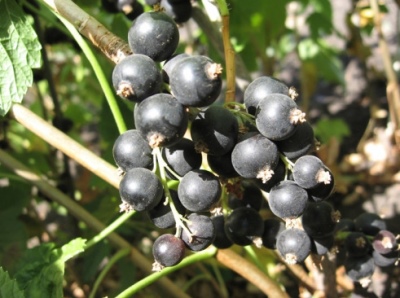
- Authors: Ukrainian selection (Institute of Horticulture UAAS)
- Ripening terms: medium late ripening
- Growth type: vigorous
- Yield: high
- Appointment: universal
- Berry weight, g: 1,9-2,2
- Escapes: upright, thick
- Sheet: slightly split, glossy
- Brush: long
- Berry color: black, shiny
A popular variety, known almost throughout the European continent, is the black currant Cherry. The advantage of the crop is large fruits and abundant yields.
Breeding history
Cherry currants on the agricultural market represent the Ukrainian selection. Work on the breeding of the culture was carried out in Kiev, at the Institute of Horticulture of the UAAS, the project was supervised by the leading breeders of the center K. Kopan and U. Kopan. As a result, in 1995, a variety was obtained by complex interspecific and interspecific crossing.
The goal of Ukrainian scientists was not just the creation of an industrial design, special attention was paid to the taste of the fruit, the size of the berries. Thanks to these characteristics, the variety gained immense popularity and became known not only in its homeland and in the CIS countries, but also throughout Europe.
Of course, the Chereshnevaya variety is included in the Ukrainian Register of Varietal Crops. Culture is not currently listed in the Russian State Register.
Description of the variety
Deciduous bush Chereshnevoy is high (up to 2 meters), has power. The same powerful and root system, in depth can reach the same 2 m. By the way, thanks to this, it can extract moisture from the ground, as a result, it can be without irrigation for a long time, it also tolerates drought well. Vigorous and erect branches are dense. On each brush, you can count up to 15-20 berries.
The foliage is large, slightly elongated or rounded in shape, with denticles along the edges. Each leaf can be 5-lobed, with a large upper lobe, others are much smaller, almost invisible. They are distinguished by their green color, with white veins and slight pubescence on the dorsum. The flowers are bisexual, lilac, the shape resembles a bell.
Characteristics of berries
The shiny berries of the Cherry are quite large, weighing from 2 to 4.5 grams. The shape is rounded, almost black in color, with a dense, but elastic skin. The inside of the fruit has an interesting green-brownish pulp. Strong peel, coupled with dry separation, makes it possible to transport the berry. Mechanized harvesting is allowed.
Taste qualities
As for the taste characteristics of Chereshneva, they are also at their best. There is a pleasant sweet and sour taste with a rich aroma. The product contains a high content of useful bioactive substances, a storehouse of vitamins, as well as micro- and macroelements.
The chemical composition of berries:
- dry matter - from 13.8 to 15.8%;
- sugar - from 12.1 to 12.9%;
- acids - from 2.4 to 2.6%;
- pectin - from 1.4 to 1.7%;
- phenol - 469 mg;
- vitamin C - from 202 to 209 mg.
Ripening and fruiting
The flowering shrub starts on May 15, which will last until the last June days. And from July 10, Chereshneva berries begin to ripen. This variety is considered medium late. However, maturation is usually amicable.

Yield
Up to 5 kg of currant fruits are usually obtained from one plant.
Landing
For planting the bushes of the described variety, a spacious area is selected, as well as a site well lit by the sun during daylight hours. This currant grows on almost any soil, but black earth loamy soil would be the best option.
The optimal time for planting is the earliest spring, even before the foliage bloom, as well as the first days of autumn.
2 weeks before the expected planting of currant bushes, holes are dug 40 centimeters deep, the distance between them is from 2 meters. Either manure or compost is applied to the bottom of the holes, mixed with superphosphate. This is all mixed with the earth taken out of the pits. If you have a heavy loamy soil on your site, dig holes deeper, from 60 cm, and put sand drainage on the bottom.
Fertilizers will need twice as much. Then ½ a bucket of water is poured into each hole. Before planting, currant bushes should be cut off, leaving up to 5 buds per shoot. Then the roots are straightened and planted vertically. It remains only to fill them with soil mixture and spill. At the end, you should tamp the earth, and put peat or humus around the trunk as mulch.

Growing and care
The care procedures for the culture will consist of:
- watering;
- loosening;
- weeding;
- removing weeds;
- top dressing.
In currants, the root system has a superficial structure, so the plant is quite moisture-loving. The main thing is to avoid stagnation of liquid at the roots.




Disease and pest resistance
The culture has good immunity, it is resistant to pest attacks, fungal and viral infections. Especially high resistance to kidney mites and diseases such as:
- powdery mildew;
- septoria;
- anthracnose.

Currant is one of the most favorite crops of gardeners, it can be found on almost any personal plot. In order for the currant berries to be tasty and large, and the bush itself to be healthy and strong, you should properly care for, treat and protect the plant from harmful insects. It is important to recognize the signs of the disease in a timely manner and begin treatment in the early stages of plant damage.
Resistance to adverse climatic conditions
Cherry currant variety is quite frost-hardy, has the ability to withstand frosts down to -30 degrees Celsius.










































































